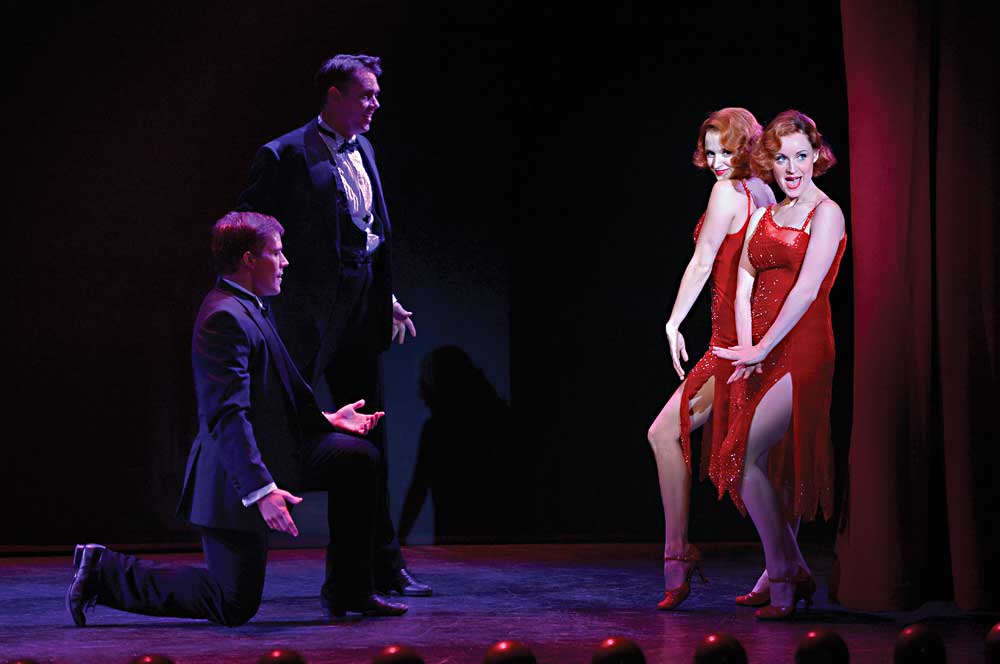“There’s an idea that informs both the old and new versions of this show, and that’s everyone’s desire to unify their inner and outer voices, and to be heard.” So says director Bill Condon about Side Show, Henry Krieger and Bill Russell’s 1997 musical about the Hilton Sisters, conjoined twins who made an improbable rise to vaudeville stardom during the 1930s. Condon’s statement crystallizes much of what’s afoot in a newly revised edition of the show, in which multiple motifs of duality and self-realization emerge make for a remarkably emotional (albeit extremely specialized) experience, as witnessed by the idiomatic rethink seen at California’s La Jolla Playhouse last fall and set to play D.C.’s Kennedy Center June 14–July 13.
A success d’estime and financial failure on Broadway, the original Side Show, directed by Robert Longbottom, virtually defines the term “cult musical.” It ran for just 91 performances, but it gained a passionate following among critics and audiences, receiving four Tony nominations, including an unprecedented joint best actress nod for Emily Skinner and Alice Ripley, whose soaring tandem performances became the stuff of Broadway legend.
The 2002 Los Angeles premiere, at Burbank’s Colony Theatre under Nick DeGruccio’s direction, enjoyed another indelible, full-throated pair in Julie Dixon Jackson and Misty Cotton. That production—much like its New York predecessor a stylized, semi-abstract fantasia—was wildly well-received. Nominated for eight Ovation awards (it won three), it is still remarked upon in near-reverential terms by area theatregoers.
Numerous regional productions have cropped up over the subsequent decades. The loyalty of Side Show’s fans is hardly less impassioned than that of its creators, for whom this reimagining is very much a labor of love. Condon, a lifelong theatre devotee who made his legit directing debut in La Jolla, came aboard three years prior to the new production, having once hoped to make a film adaptation. “I saw the Broadway and Burbank productions two times each, and each time, I was struck anew by how special it was,” says the Oscar-winning screenwriter (for Gods and Monsters).
Fittingly enough, it was Condon’s experience as director and scripter of the 2006 film adaptation of Krieger and Russell’s Dreamgirls that ultimately propelled him toward this project. “Remember, at least 40 per cent of Dreamgirls was shot in theatres,” notes Condon, who mentions that he caught the show on its 1981 opening night from the balcony of New York’s Imperial Theatre. “And it was such a satisfying experience, working with Bill and Henry. We didn’t want to stop being collaborators and friends.” Says composer Kreiger, “As we were winding down production on the film, I asked him if he’d be interested in doing a stage musical.” Condon’s response: “Would I ever!” It was Condon who brought up revisiting Side Show, and the trek toward a new vision began, with a staged workshop at New York’s Roundabout Theatre Company in 2008, and now this full-fledged new take.
The basic approach, Condon says, is different. “We’re basically turning what was at heart a backstage musical into more of a biographical piece. It’s hopefully more grounded in reality, without being too literal, though—it is a musical, after all. For example, Harry Houdini, who was a big promoter of these girls—the first person in show business who tried to teach them how to individuate themselves from each other—now figures into the plot.”
Russell, author of the beauty-contest satire Pageant and the AIDS cantata Elegies for Angels, Punks and Raging Queens, observes that “the Hilton Sisters were multi-talented. They sang, they danced, they played musical instruments. But it’s the facts of their story that are what’s most fascinating.” With that in mind, the team sent Condon everything they’d written for the show over the five-plus years before its Broadway debut.
What Condon refers to as “a dramaturgical dig” resulted, with the director trying to get at the core of what had been written for refreshed insights. “He went over literally every syllable and note,” recalls Russell. “We had this opportunity to reexamine, and that’s exactly what we’ve done.” Krieger notes, “There are some big songs gone, and 12 new songs, including some previously cut numbers. Also, certain songs, such as ‘I Will Never Leave You,’ which was originally the Act 2 climax, now is first heard in Act 1 as a lullaby in flashback.”
Some extant roles have been expanded. The sardonic side-show boss is now named Sir, and he is Daisy and Violet’s sadistic guardian; he’s based on Myer Myers, the real-life brother-in-law of Mary Hilton, the Brighton midwife who bought the twins from their unwed barmaid mother in 1908. The three males who figure into the Hiltons’s lives—the carnival’s “Cannibal King” and Violet-smitten protector, Jake; hotshot agent Terry Connor; and song-and-dance man Buddy Foster—have been retooled, and the ensemble of carnival freaks, their conditions originally just suggested, are now depicted in full representation.


